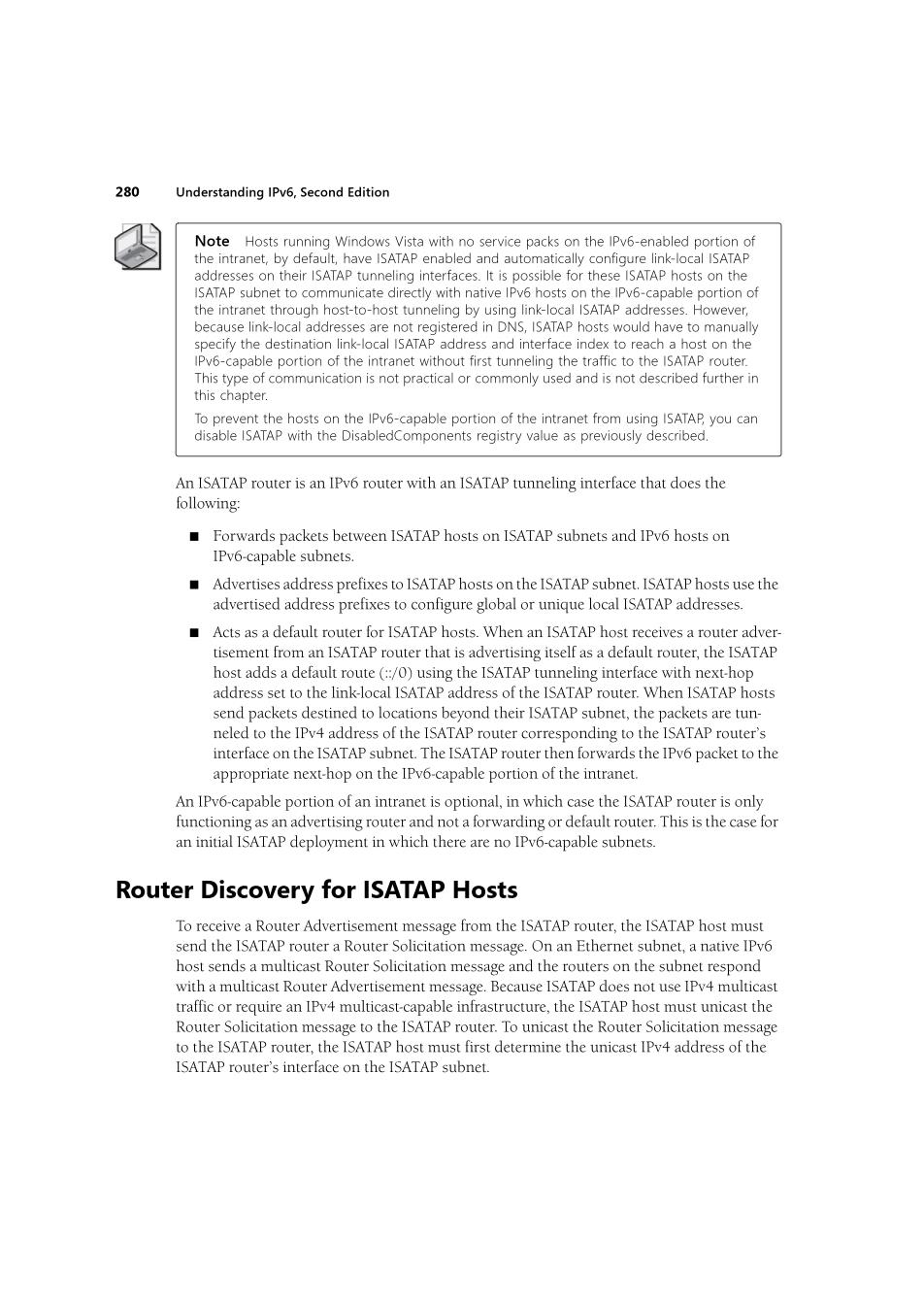正在加载图片...

280 Understanding IPv6,Second Edition Note Hosts running Windows Vista with no service packs on the IPv6-enabled portion of the intranet,by default,have ISATAP enabled and automatically configure link-local ISATAP addresses on their ISATAP tunneling interfaces.It is possible for these ISATAP hosts on the ISATAP subnet to communicate directly with native IPv6 hosts on the IPv6-capable portion of the intranet through host-to-host tunneling by using link-local ISATAP addresses.However, because link-local addresses are not registered in DNS,ISATAP hosts would have to manually specify the destination link-local ISATAP address and interface index to reach a host on the IPv6-capable portion of the intranet without first tunneling the traffic to the ISATAP router. This type of communication is not practical or commonly used and is not described further in this chapter. To prevent the hosts on the IPv6-capable portion of the intranet from using ISATAP you can disable ISATAP with the DisabledComponents registry value as previously described. An ISATAP router is an IPv6 router with an ISATAP tunneling interface that does the following: Forwards packets between ISATAP hosts on ISATAP subnets and IPv6 hosts on IPv6-capable subnets. Advertises address prefixes to ISATAP hosts on the ISATAP subnet.ISATAP hosts use the advertised address prefixes to configure global or unique local ISATAP addresses. Acts as a default router for ISATAP hosts.When an ISATAP host receives a router adver- tisement from an ISATAP router that is advertising itself as a default router,the ISATAP host adds a default route(:/0)using the ISATAP tunneling interface with next-hop address set to the link-local ISATAP address of the ISATAP router.When ISATAP hosts send packets destined to locations beyond their ISATAP subnet,the packets are tun- neled to the IPv4 address of the ISATAP router corresponding to the ISATAP router's interface on the ISATAP subnet.The ISATAP router then forwards the IPv6 packet to the appropriate next-hop on the IPv6-capable portion of the intranet. An IPv6-capable portion of an intranet is optional,in which case the ISATAP router is only functioning as an advertising router and not a forwarding or default router.This is the case for an initial ISATAP deployment in which there are no IPv6-capable subnets. Router Discovery for ISATAP Hosts To receive a Router Advertisement message from the ISATAP router,the ISATAP host must send the ISATAP router a Router Solicitation message.On an Ethernet subnet,a native IPv6 host sends a multicast Router Solicitation message and the routers on the subnet respond with a multicast Router Advertisement message.Because ISATAP does not use IPv4 multicast traffic or require an IPv4 multicast-capable infrastructure,the ISATAP host must unicast the Router Solicitation message to the ISATAP router.To unicast the Router Solicitation message to the ISATAP router,the ISATAP host must first determine the unicast IPv4 address of the ISATAP router's interface on the ISATAP subnet.
!" #$%
&$
' (
) *(+&*,
'(-.)/0( &12(#+
3
'(
& (
415#(3&
2
4'&)(-6787.( &12(#& #&
9&
*&225* 3 !
(2 ,02*&2-6787. &##
((
'(
-6787.
(2 !
(
3&*(:-
+ 12(3
'((-6787.'
'( -6787.
1 (
*99
*&
(#
(*
25$
' &
)(-.)/'
'(-.)/0*&+&12(+
3
'(
& (
'
!''
0
0'
(2 !15
!2 ,02*&2-6787.&##
((:$()(
4 1(*&
(2 ,02*&2&##
((&
(
(!
(
(# ;<64-6787.'
$
2#'&)(
9&
&225 +(* 35
'(#(
&
2 ,02*&2-6787.&##
(& #
(
3&*( #(=
(&*'&'
'( -.)/0*&+&12(+
3
'(
& (
$
'
3
(2 !
'(
&33 *
'(-6787.
(
: 8'
5+(3*99
*&
+
&*
*&2
*99 25
(#& #
#(*
1(#3
'(
' *'&+
(
: 8+
()(
'('
'(-.)/0*&+&12(+
3
'(
& (
3
9
!-6787.45
*& # &12(-6787.$
'
'(; &12(#>9+ (
(!
5)&2
(&+
()
25#(*
1(#: ?@AB?C?DEFGHIEJKL@ADMNEFGHIEOJHPL@AB?C?DHG@@IQJ@RJ@HIESLTIHPLHUFIKHPI SFQQFOJ@RV W XFEOLEUKYLTZIHK[IHOII@AB?C?DPFKHKF@AB?C?DKG[@IHKL@UADMNPFKHKF@ ADMN\TLYL[QIKG[@IHK] W ?UMIEHJKIKLUUEIKKYEISJ^IKHFAB?C?DPFKHKF@HPIAB?C?DKG[@IH]AB?C?DPFKHKGKIHPI LUMIEHJKIULUUEIKKYEISJ^IKHFTF@SJRGEIRQF[LQFEG@J_GIQFTLQAB?C?DLUUEIKKIK] W ?THKLKLUISLGQHEFGHIESFEAB?C?DPFKHK]`PI@L@AB?C?DPFKHEITIJMIKLEFGHIELUMIE\ HJKIaI@HSEFaL@AB?C?DEFGHIEHPLHJKLUMIEHJKJ@RJHKIQSLKLUISLGQHEFGHIEbHPIAB?C?D PFKHLUUKLUISLGQHEFGHIcVVdefGKJ@RHPIAB?C?DHG@@IQJ@RJ@HIESLTIOJHP@I^H\PFY LUUEIKKKIHHFHPIQJ@Z\QFTLQAB?C?DLUUEIKKFSHPIAB?C?DEFGHIE]`PI@AB?C?DPFKHK KI@UYLTZIHKUIKHJ@IUHFQFTLHJF@K[IgF@UHPIJEAB?C?DKG[@IHbHPIYLTZIHKLEIHG@\ @IQIUHFHPIADMhLUUEIKKFSHPIAB?C?DEFGHIETFEEIKYF@UJ@RHFHPIAB?C?DEFGHIEiK J@HIESLTIF@HPIAB?C?DKG[@IH]CPIAB?C?DEFGHIEHPI@SFEOLEUKHPIADMNYLTZIHHFHPI LYYEFYEJLHI@I^H\PFYF@HPIADMN\TLYL[QIYFEHJF@FSHPIJ@HEL@IH] ?@ADMN\TLYL[QIYFEHJF@FSL@J@HEL@IHJKFYHJF@LQbJ@OPJTPTLKIHPIAB?C?DEFGHIEJKF@Qg SG@THJF@J@RLKL@LUMIEHJKJ@REFGHIEL@U@FHLSFEOLEUJ@RFEUISLGQHEFGHIE]CPJKJKHPITLKISFE L@J@JHJLQAB?C?DUIYQFgaI@HJ@OPJTPHPIEILEI@FADMN\TLYL[QIKG[@IHK] jklmnopqrsktnouvkowxyzy{|krmr CFEITIJMIL}FGHIE?UMIEHJKIaI@HaIKKLRISEFaHPIAB?C?DEFGHIEbHPIAB?C?DPFKHaGKH KI@UHPIAB?C?DEFGHIEL}FGHIEBFQJTJHLHJF@aIKKLRI]~@L@HPIE@IHKG[@IHbL@LHJMIADMN PFKHKI@UKLaGQHJTLKH}FGHIEBFQJTJHLHJF@aIKKLRIL@UHPIEFGHIEKF@HPIKG[@IHEIKYF@U OJHPLaGQHJTLKH}FGHIE?UMIEHJKIaI@HaIKKLRI]ITLGKIAB?C?DUFIK@FHGKIADMhaGQHJTLKH HELSSJTFEEI_GJEIL@ADMhaGQHJTLKH\TLYL[QIJ@SELKHEGTHGEIbHPIAB?C?DPFKHaGKHG@JTLKHHPI }FGHIEBFQJTJHLHJF@aIKKLRIHFHPIAB?C?DEFGHIE]CFG@JTLKHHPI}FGHIEBFQJTJHLHJF@aIKKLRI HFHPIAB?C?DEFGHIEbHPIAB?C?DPFKHaGKHSJEKHUIHIEaJ@IHPIG@JTLKHADMhLUUEIKKFSHPI AB?C?DEFGHIEiKJ@HIESLTIF@HPIAB?C?DKG[@IH]��